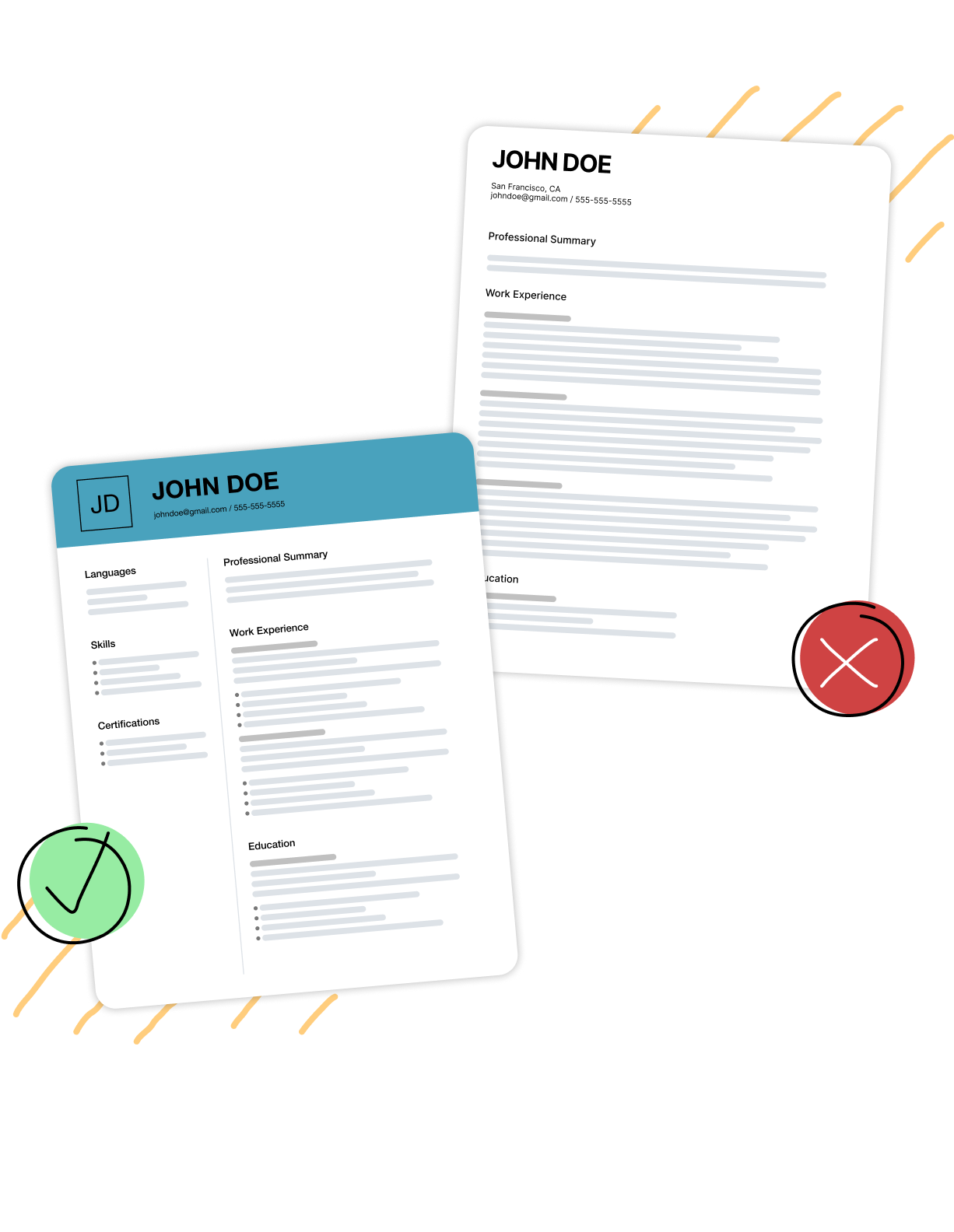It may not surprise you to learn that many hiring managers rely on automation and even artificial intelligence (AI) to help them find highly qualified job candidates.
Applicant tracking systems (ATS) are now a key component of the job hiring process, which means resumes need to be compatible with these systems so that they are properly scanned and analyzed. If not, your application may be rejected simply because it did not meet basic formatting requirements.
That is why it is so important to make your resume ATS-friendly. But what is an ATS-friendly resume? Resume Now will answer your questions and help you build one.
This guide will show you:
- What an ATS resume is
- How an ATS scans resumes
- How to write a resume that beats an ATS
- ATS-friendly resume templates
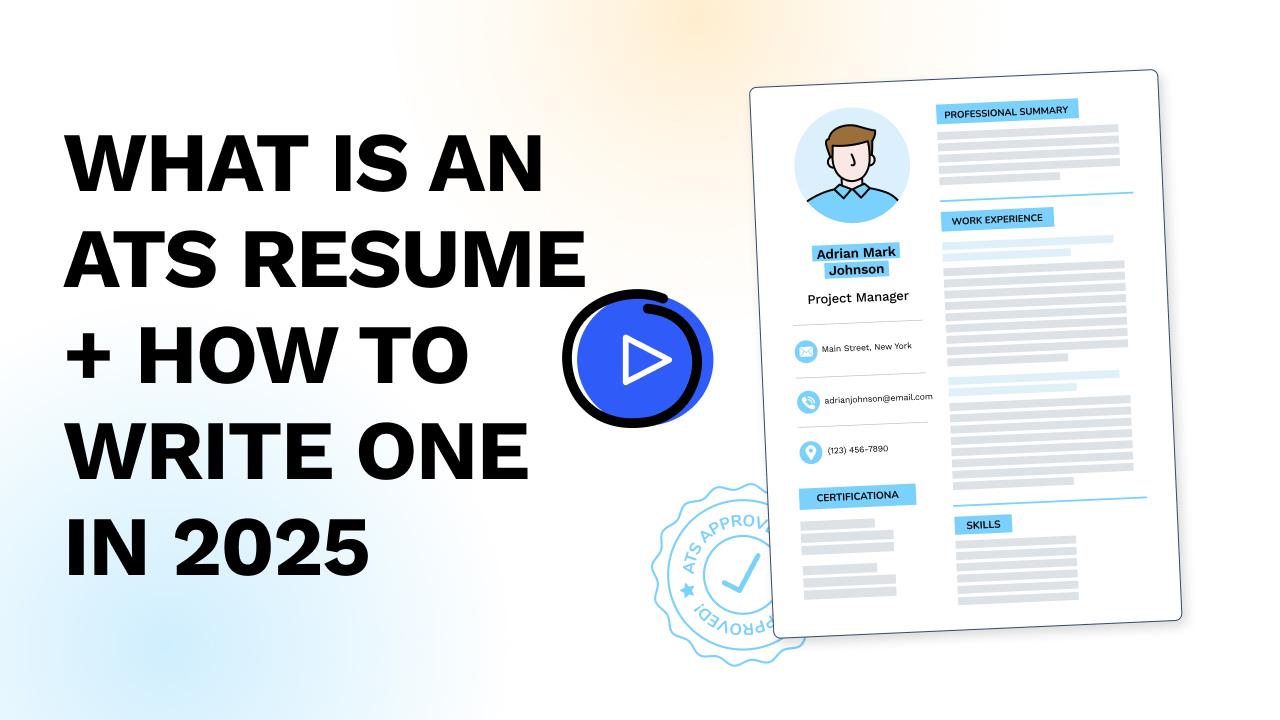
Want to make sure your resume is ATS-friendly? Try Resume Now’s ATS Resume Checker to analyze your current resume’s ATS performance. Or, use our AI Resume Builder to make an ATS resume quickly. Upload your resume or start a new one, choose a customizable template, and fill it out with generated suggestions tailored to your needs.
What Is an ATS Resume?
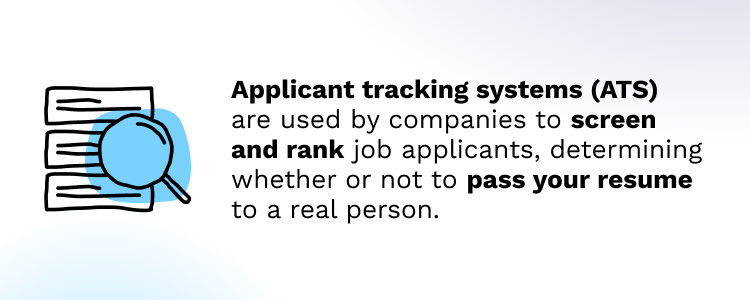
An ATS resume is any resume that is optimized for applicant tracking systems, or ATS.
An ATS is software used during the hiring process to sort and rank job applicants automatically. Most ATS scan resumes for specific qualifications and keywords to find the most qualified candidates for the role. This saves the employer time, but it can result in unoptimized resumes being filtered out.
If your resume is not formatted correctly or if you use unfamiliar language, an ATS might remove you from consideration even if you are extremely qualified.
So, how do you avoid this and make an ATS resume? First, you need to understand how they work.
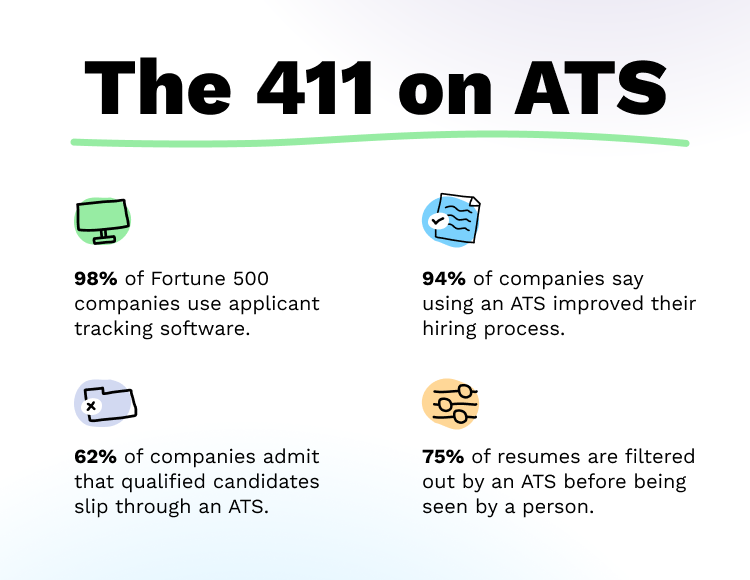
How does an ATS work?
An ATS can’t read your resume the way a human would. Instead, it scans resumes for keywords often listed in the job description and matches them to their list of prerequisite skills and metrics desired by the employer.
For example, your resume profile might read:
“Detail-oriented marketing professional with over five years of advertising agency experience in end-to-end campaign management. Led a team of media buyers and media planners to implement cross-channel digital marketing campaigns.”
While a human could pick up on the subtle nuances and context clues, an ATS is trained to scan and pick out keywords. Here’s what the ATS would likely see:
- Detail-oriented
- Over five years of experience
- Advertising agency
- Led a team
- Cross-channel digital marketing campaigns
The ATS will then cross-reference your qualifications with what the company is looking for and rank you against other candidates. If you pass a certain threshold, your resume is likely passed along to the relevant hiring manager to take a closer look. This threshold depends on the specific role, but there are ways of making a close estimate and optimizing your resume to meet ATS expectations.
How to Write an ATS Resume in 8 Steps
Before focusing on ways to impress recruiters, you must write a resume that can be read by an ATS; otherwise, it might never be seen by the hiring manager.
How do you do it? Follow these eight steps to ensure your resume makes it past this initial scan.
If you need more guidance, check out our resume examples library.
1. Pick the right layout
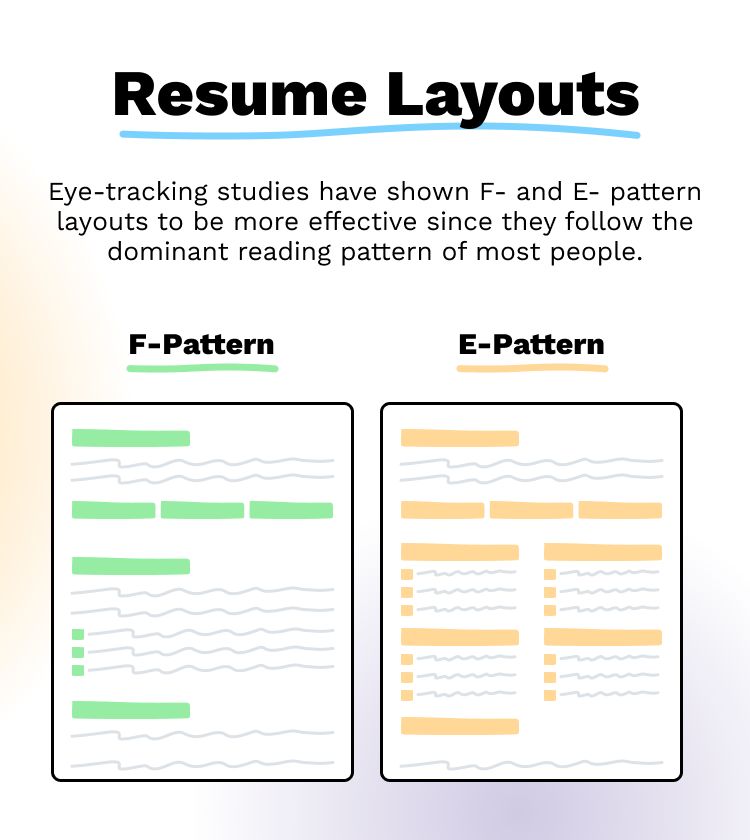
Many qualified applicants are rejected because the ATS software can’t read their resumes.
Picking a resume template with a simple layout, logical hierarchy, and easy-to-read font can be the difference between getting the call for an interview and having your resume discarded before it’s even seen.
Here are two particular problem areas in resume layouts:
- Headers and footers: While humans can easily contextualize information in these resume areas, some applicant tracking systems cannot identify vital details commonly stored here, like contact information. It’s best to avoid placing vital information in a designated header or footer.
- Columns: Some applicant tracking systems will read columns left to right instead of column by column, meaning that your neatly arranged columns will become jumbled and indiscernible to the ATS. Stick to a simple layout to ensure your info isn’t scrambled by incorrect formatting.
2. Use an easy-to-read font
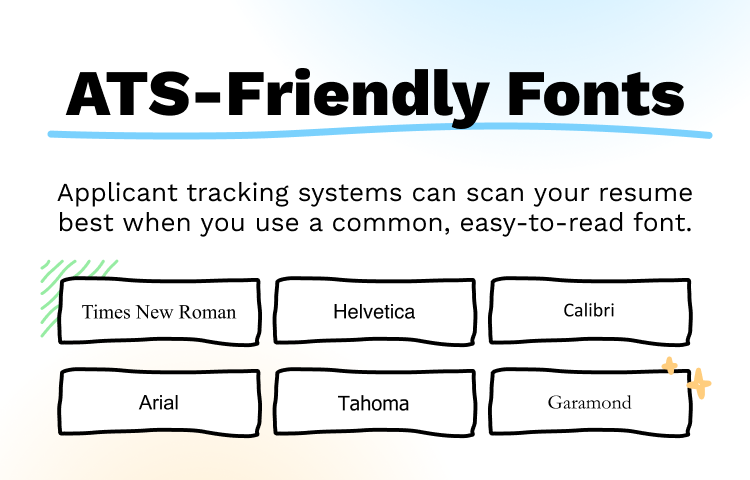
Similar to the layout, ATS can best scan your resume when you use a clear, easy-to-read font like Times New Roman, Helvetica, Calibri, Arial, Tahoma, or Garamond.
You should also consider font size. While some people use the smallest size possible to fit more information, it’s best to stick to the standard 12-point font on your resume.
For important text like your name or section headings, it’s good practice to size these headings no more than double your smallest font—keeping these titles in 24-point font or smaller is best.
It’s easy to underestimate the importance of fonts on your resume, but these days, you need to design your resume for both humans and bots. If it’s done right, hiring managers probably won’t even notice—but when it’s done wrong, your font choice can significantly detract from the quality of your application.
3. Use standard formatting
While beautifully designed resumes may be striking to the human eye, some ATS may be unable to read them. Here’s where you can use resume formats to your advantage.
When creating an ATS-compatible resume, it’s best to avoid fancy formatting like:
- Tables: An ATS may not read the information in a table in the correct order.
- Logos: The ATS won’t pick up what the logo says, equating to wasted resume space.
- Images: Many image files aren’t compatible with ATS software.
- Graphics: The ATS may not be able to interpret information in a graphic correctly.
- Text boxes: The ATS may be confused by the information hierarchy of a text box.
Instead, try using formatting styles that won’t confuse an ATS if the resume is converted to a plain-text file, such as:
- Bold
- Italics
- Underline
- Colors
- Bullets
Many applicant tracking systems will convert your resume to a text-only file, meaning much of the fancy formatting you use will get lost. Using text-only modifications will ensure that the ATS doesn’t miss out on valuable information in your resume.
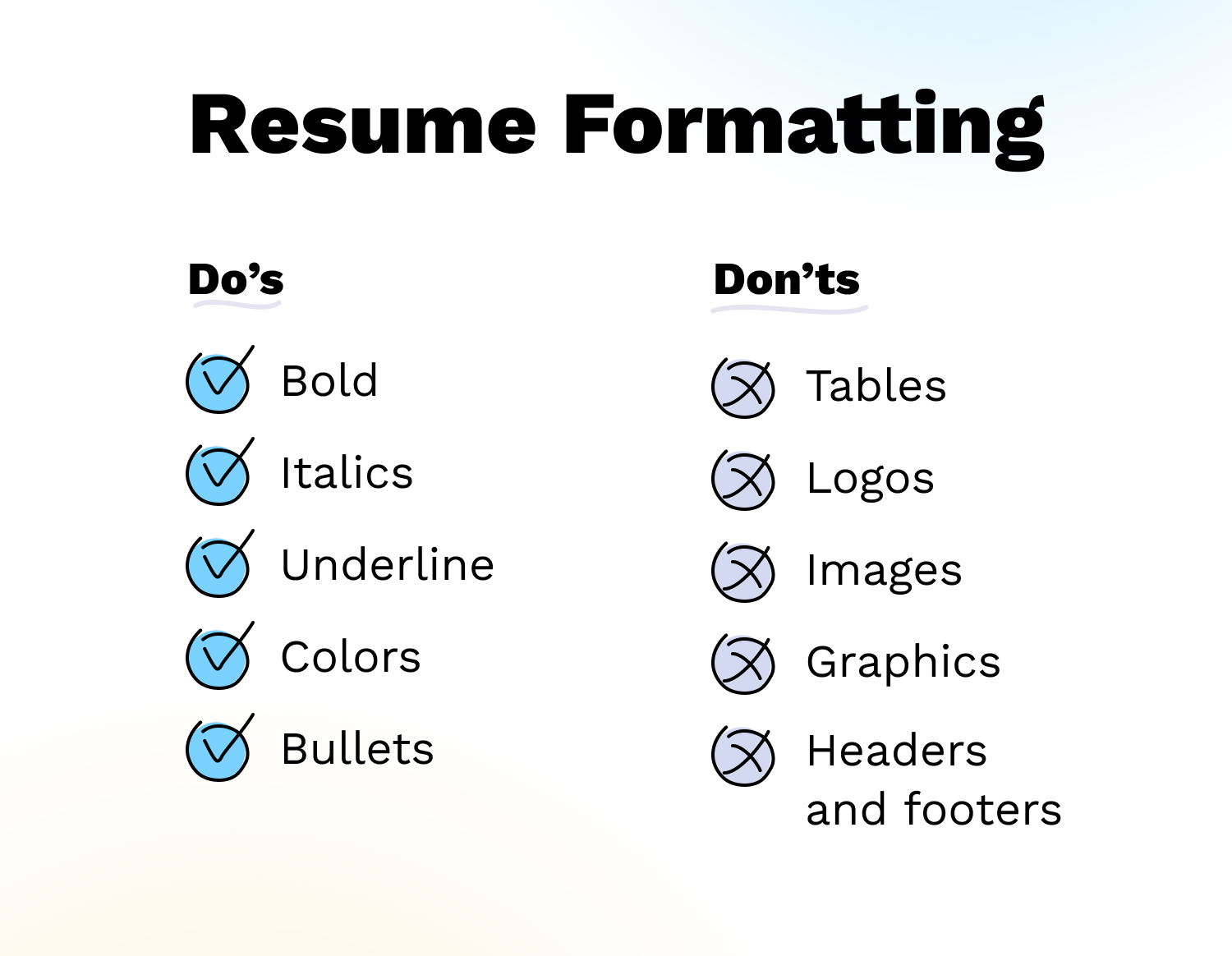
4. Use clear, concise headings
Stick to conventional headings like “Work Experience,” “Education,” and “Certifications” to convey your message.
The top half of your resume is the most valuable space since it’s what a hiring manager likely looks at first, so you should also list your headings in order of importance.
Start with an objective statement or professional summary. Then, your work experience should sit in this prime real estate if you’ve been out of school for a few years and have significant work experience.
However, if you’re a student searching for an internship, it might be more prudent to put your education in the top spot to downplay a lack of work experience.
5. Tailor with appropriate keywords
Now that your formatting choices are on point, it’s time to ensure that your resume is ATS-friendly from a content perspective.
Tailoring your resume to each position is crucial to creating a bot-proof job application. One-size-fits-all resumes are a thing of the past, and these days, the best applicants take keywords from the job description and contextualize them on their resumes to get past the ATS.
However, it’s important to know how to incorporate these keywords correctly. While you could pull keywords from the job description and list them all under a skills section, some ATS automatically assign a mere six months of experience to any skill listed without an exact date.
Instead, incorporate your keywords into your work history or other relevant sections by following a “show, don’t tell” mindset.
Using context is especially important for showcasing soft skills. While you could list soft skills like collaboration, teamwork, and attention to detail, showing how you’ve used them in your work history will provide much more value than mentioning them in a skills section.
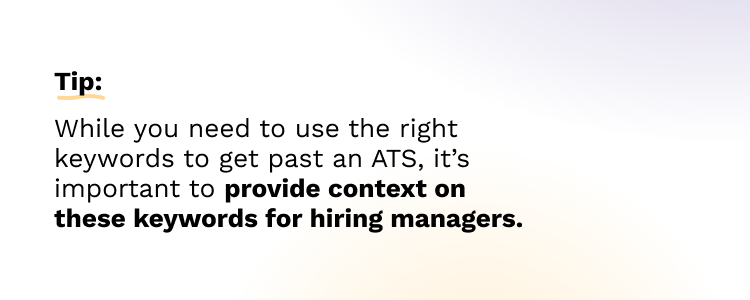
6. Quantify your achievements
If tailoring your resume helps you stand out by including relevant keywords, then quantifying it allows the ATS to more accurately understand and potentially rank your resume.
By adding measurable work experience, particularly with accomplishments, you help your resume stand out with unique metrics that the ATS and the hiring manager can easily see.
Additionally, quantifying your job history helps underscore your value as an employee, which can help convince the hiring manager to interview you.
In your bulleted list under the job title, use the format of [action verb] + [specific responsibility] = [measurable result].
For example:
“Managed a 12-member sales team during a six-month initiative that increased revenue by 57% YoY.’’
The applicant tracking system will pick up on this data and present it to the hiring manager, who can then connect your skills to your impact.
7. Get the file name right
An easy way to customize your resume is to use a standard, customized file name. However, many job applicants make the mistake of sending in an unprofessional or untidy file name.
Take a look at the below examples:
- Sarah-Smith-January2025-Resume.pdf
- Sarah-Smith-Resume-7.pdf
Now compare the above resume file names to these:
- Sarah-Smith-Marketing-Coordinator.pdf (or .docx)
- Sarah-Smith-Marketing-Coordinator-Google.pdf
The second set of file names looks more put together and personalized. Many people make the mistake of including dates or numbers in their resume, and while this may not seem like a big deal, it might leave recruiters thinking that your so-called skill of “attention to detail” may not be as accurate as it sounds.
8. Use the correct file format
One of the most common misconceptions is that an ATS can’t read PDF files. While there’s nothing wrong with making your resume in a Word doc, applicant tracking systems have just as much difficulty reading a Word doc if you put your content in a header, table, or column as they would a PDF.
It’s best practice to create multiple resume file types and submit whichever seems most prudent in your particular situation or whatever the employer specifically requests. For example, a PDF resume can be advantageous if you have extra formatting.
Be sure to convert your resume to a plain-text file as well. To do this, copy your resume into a plain text document without formatting and check the results. You’ll want to look for things like disorganized headings, scrambled words, or missing details from the original resume.
5 ATS-Friendly Resume Templates
Consider using an ATS-friendly resume template to help you pass the screening. By using such a template, you can save yourself a lot of worry about whether or not your resume will be compatible.
Check out the following ATS resume designs and try one that fits your style.
ATS resume template – Contemporary
ATS resume template – Upgrade
ATS resume template – Iris
ATS resume template – Aster
ATS resume template – Standard
ATS Resume FAQ
Last Updated: August 15, 2025
You need an ATS-friendly resume because most companies today use applicant tracking systems to manage the large number of applications they receive for each job posting. If your resume isn’t formatted or written to be ATS-compatible, it could be rejected before it ever reaches a recruiter or hiring manager.
ATS software scans for specific criteria, and if your resume lacks these elements or includes features like complex formatting, the system might fail to process it correctly. This could result in your application being overlooked, even if you’re highly qualified.
The best ATS-friendly resume is the chronological resume. Chronological formats put your job history at the forefront, and an ATS is designed to read work history. Not to mention that’s where the bulk of your keywords should be.
But you can find ATS-friendly versions of other resume formats, like functional and combination resumes. Either of these formats is a good choice for a candidate who wants to emphasize skills over experience. The proper use of fonts and other formatting elements is more important than the placement of sections.
You must be careful about what you include to get your resume past an ATS.
Here’s what you should avoid when you make an ATS resume:
- Unusual fonts
- Graphics
- Tables
- Logos
- Images
- Text boxes
If you aren’t sure whether your resume is ATS-friendly, go with a template created by a professional.
Two-page resumes are fine for applicant tracking systems. In fact, since two-page resumes can help you include more keywords, they can give you an advantage in getting picked up by an ATS.
Remember—only use a two-page resume if you have at least five or maybe 10 years of professional experience. You don’t want to stretch your career history thin when you add a second page.
Many years ago, most applicant tracking systems had trouble reading PDFs. But that’s changed. Today, the major programs can read Word documents and PDFs equally well.
Always make sure to see which file format the employer prefers. Sometimes, they will list the format they prefer in the application portal.
Yes, many ATS systems rank resumes based on how well they match the job posting’s requirements. This ranking is determined through algorithms that evaluate factors like the presence of relevant keywords, the amount of relevant work experience, and how well your qualifications align with the job description.
The system then assigns a score or ranking to your resume, often compared against other applicants. Higher-ranked resumes are more likely to be forwarded to recruiters or hiring managers for further review.
This ranking process is why tailoring your resume for each job application is crucial. By aligning your resume with the job description, you can improve your ranking and increase the likelihood that your resume is seen by a decision-maker.
To make an ATS-friendly resume summary, you will want to:
- Use keywords: Match skills and qualifications from the job description (e.g., "project management, "data analysis").
- Highlight hard skills: Focus on specific abilities like SEO, coding, or leadership.
- Quantify achievements: Include measurable results (e.g., "Increased sales by 20%").
- Keep it simple: Avoid jargon or creative language; use clear, professional terms.
- Write concisely: Limit your summary to three to four sentences.
- Avoid formatting issues: Place your summary in the main body of your resume.
- Tailor to the job: Customize your summary for each application to meet ATS criteria.
If you need help, use our AI Resume Summary Generator to come up with a profile that highlights your best qualifications for applicant tracking systems and hiring managers alike.
Was this information about What Is An ATS Resume? How To Write An ATS-Friendly Resume In 2025 helpful? Let us know!
Don is a Certified Professional Resume Writer (CPRW) with more than 10 years’ experience creating digital content, including four years helping job seekers develop their careers. He holds an M.S. in Journalism from Northwestern University.
More resources

63% Expect AI’s Role in Compensation to Grow Significantly in the Next 5 Years
Resume Now s latest report examines how workers are responding...

How to Include Research Skills on a Resume: 40+ Examples
Check out our guide to understand what research skills are and...

How To Write a CV: The Ultimate Guide for 2025
Here is a complete and comprehensive guide to writing a CV ev...
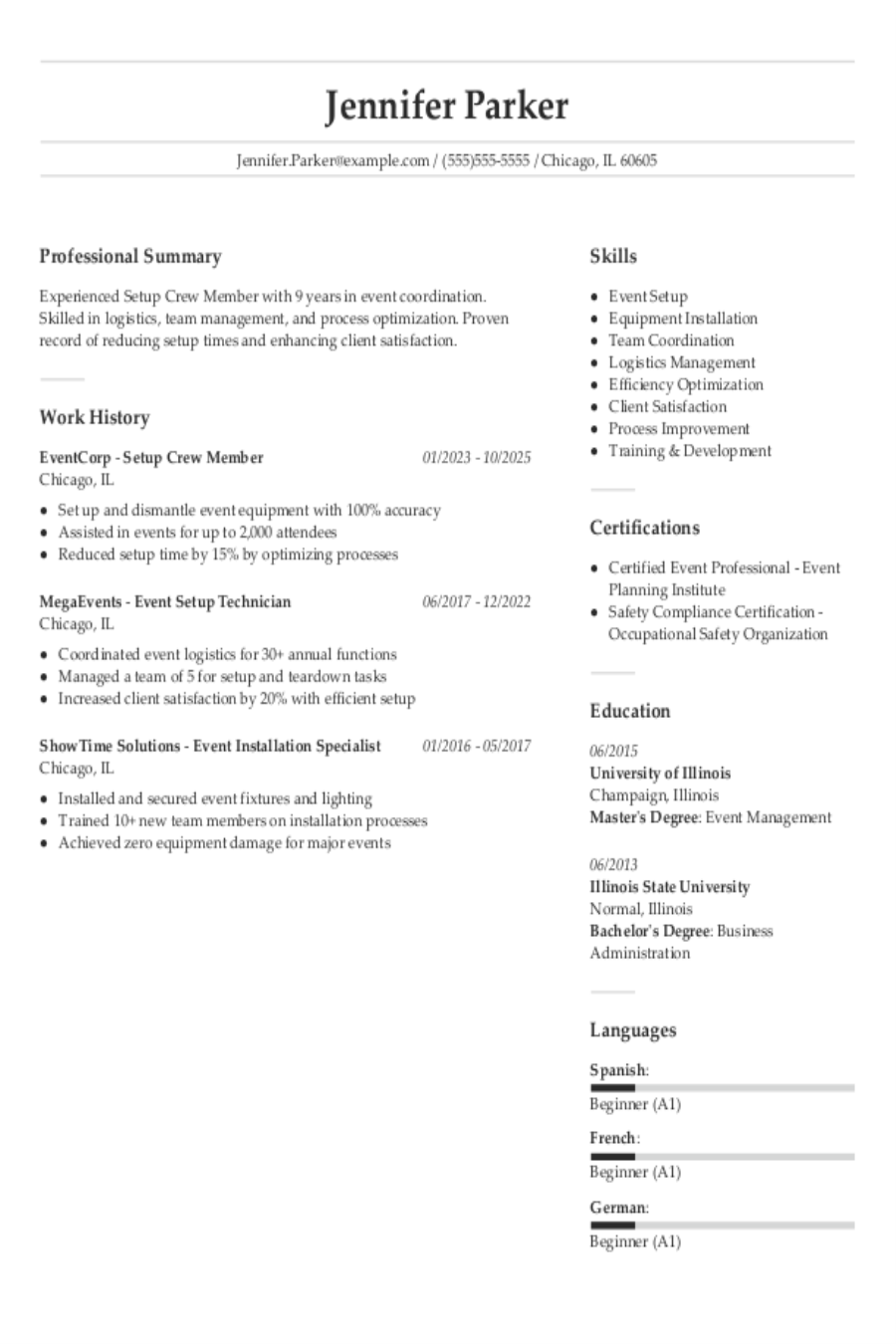
Event Setup Resume: Examples, Templates & Tips for 2025
Excited about diving into a dynamic new position in event setu...
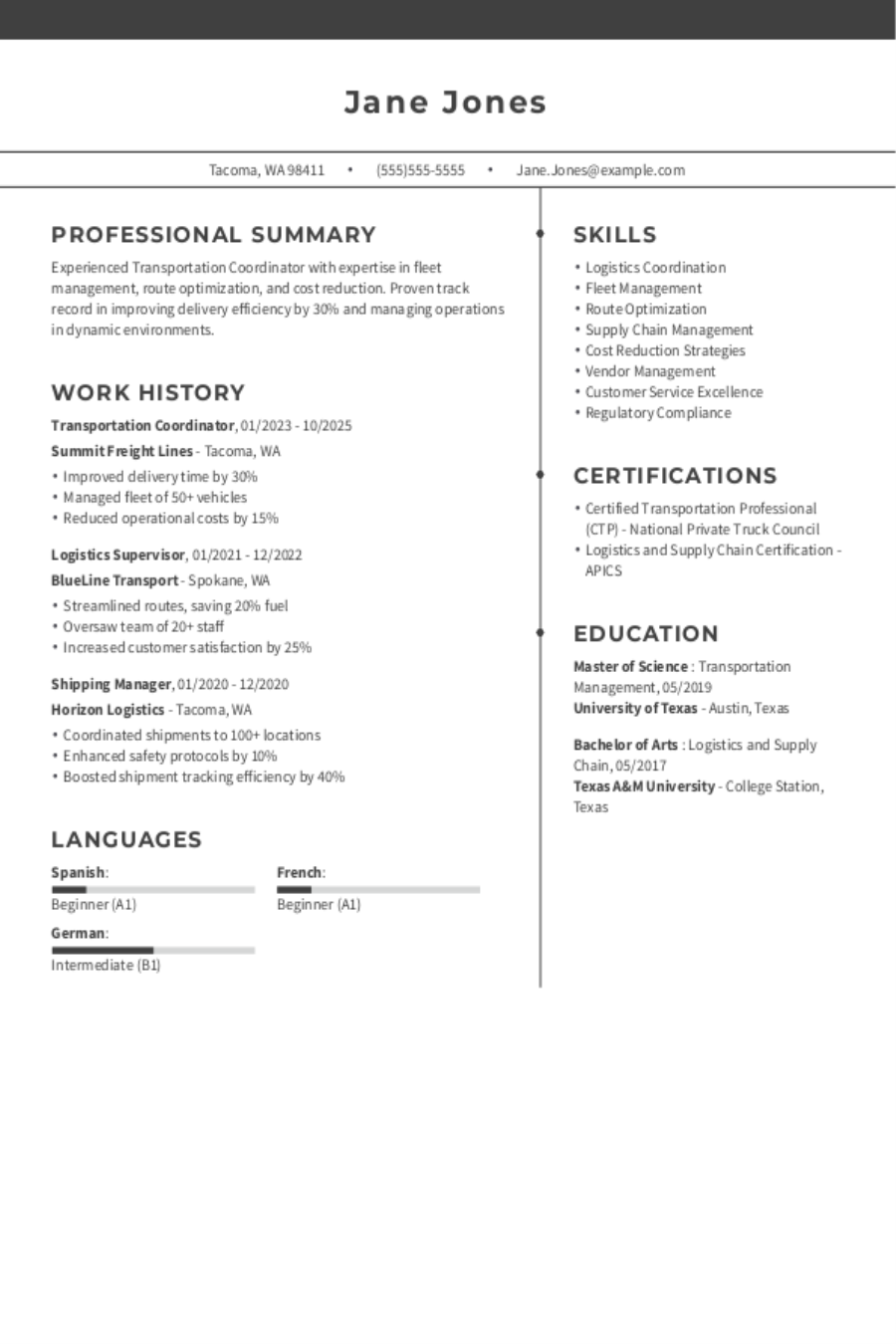
Transportation Coordinator Resume Example
Build & download your Transportation Coordinator resume in a f...
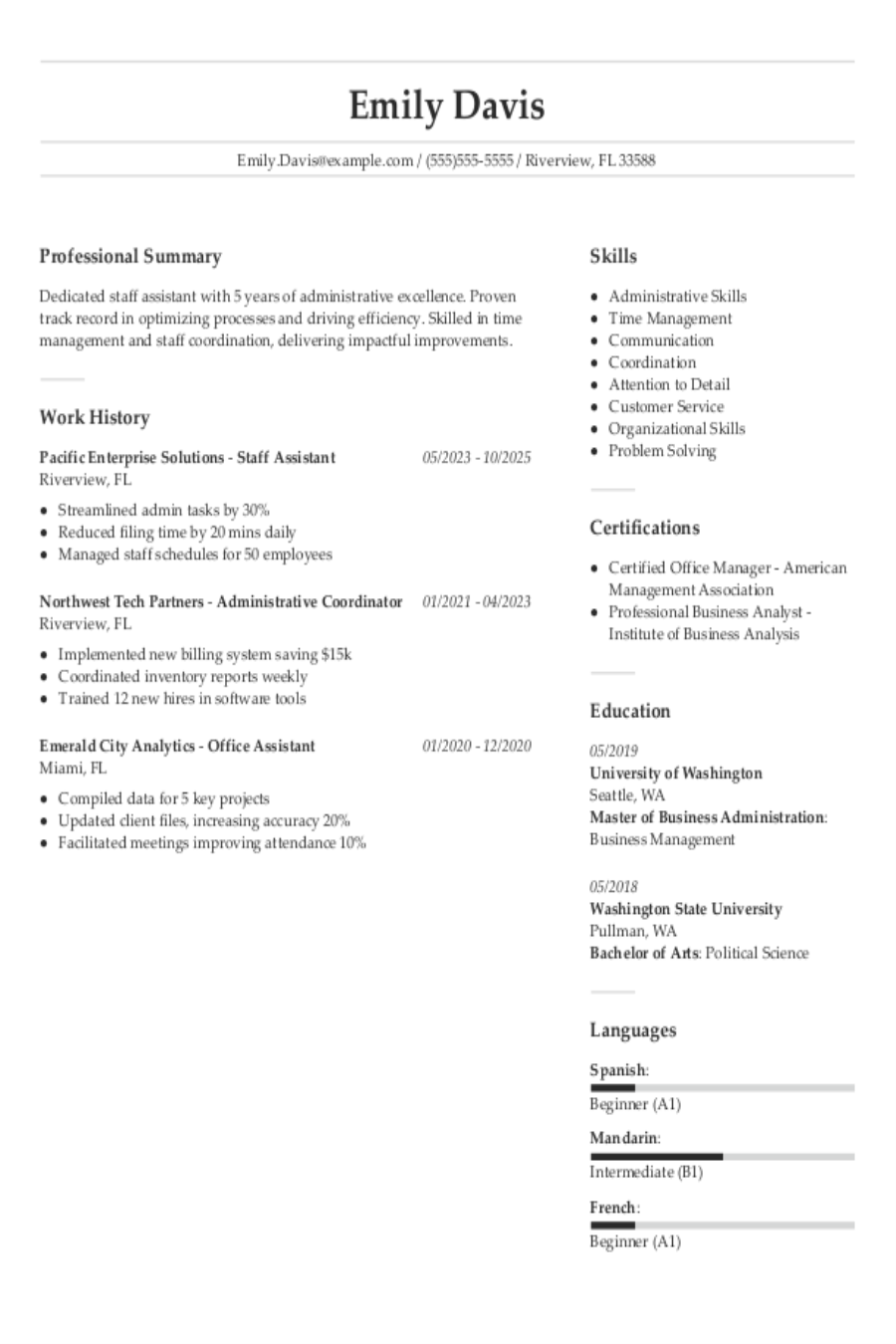
Staff Training Assistant Resume Example
Build & download your Staff Assistant resume in a few simple s...

